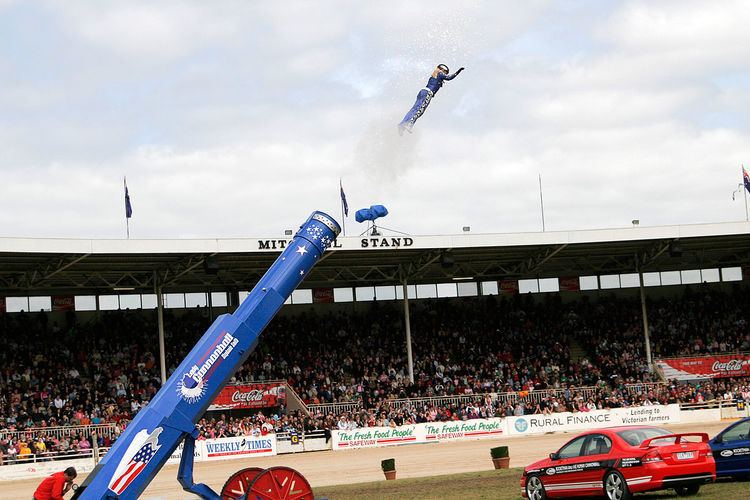 | ||
The human cannonball act is a performance in which a person (the "cannonball") is ejected from a specially designed "cannon". The human cannonball lands on a horizontal net or inflated bag placed at the landing point, as predicted by physics. Outdoor performances may aim at a body of water.
Contents
History
The first human cannonball, launched in 1877 at the Royal Aquarium in London, was a 14-year-old girl called "Zazel", whose real name was Rossa Matilda Richter. She was launched by a spring-style cannon invented by Canadian William Leonard Hunt ("The Great Farini"). She later toured with the P.T. Barnum Circus. Farini's cannon used rubber springs to launch a person from the cannon, limiting the distance he or she could be launched. Richter's career as a human cannonball ended when a launch went awry and she broke her back.
In the 1920s, Ildebrando Zacchini invented a cannon that used compressed air to launch a human cannonball. Zacchini shot his son Hugo Zacchini out of the compressed air cannon. Members of the Zacchini family were later inducted into the Ringling Brothers Circus Hall of Fame.
World record
There is a claim that the current world record for the longest human cannonball flight is 193 ft 8.8 in (59.05 m), established by David Smith Jr. on the set of Lo Show Dei Record, in Milan, Italy, on March 10, 2011. The distance was measured from the mouth of the cannon to the farthest point reached on the net. David Smith Jr. was launched by an 8 m (26' 3") long cannon. It was estimated that he travelled at a speed of 120 km/h (74.6 mph), reaching a maximum altitude of 23 m (75' 6").
There is, however, a contradictory claim that Smith's father, David "Cannonball" Smith Sr., set a record of 200 ft 4 in (61.06 m), on August 31, 2002, at The Steele County Free Fair, Owatonna, Minnesota in the United States. It is estimated that Smith Sr. traveled at over 70 miles per hour (110 km/h) during the flight.
Cannon
The "cannon" used does not work like a regular cannon, since that would blast the human into pieces. The impetus is provided not by gunpowder but by either a spring or jet of compressed air. This makes the device work more like a catapult, where the cylinder propelling the human stops at the mouth of the cannon.
In a circus performance, gunpowder may be used to provide visual and auditory effects unrelated to the launching mechanism. Fireworks and smoke may also be used to increase the visual effect.
Risk
Being shot out of the cannon is not the main risk; landing safely is. More than 30 human cannonballs have died during the performance of this stunt. Among the latest was that which occurred in Kent, United Kingdom on April 21, 2011, where a human cannonball died as a result of the failure of the safety net.
